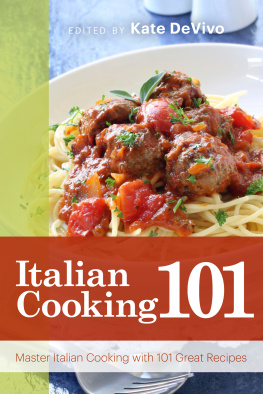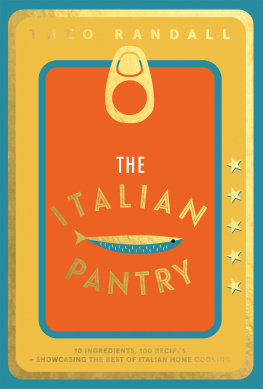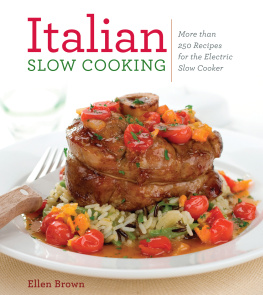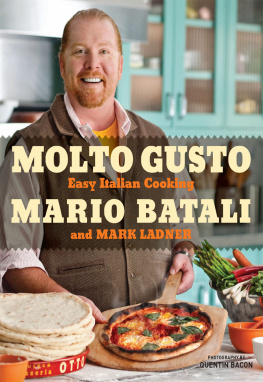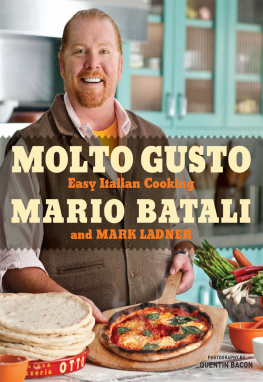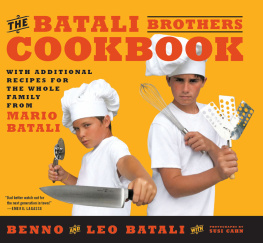Batali - Molto gusto: easy italian cooking
Here you can read online Batali - Molto gusto: easy italian cooking full text of the book (entire story) in english for free. Download pdf and epub, get meaning, cover and reviews about this ebook. year: 2010;2014, publisher: HarperCollins e-Books, genre: Home and family. Description of the work, (preface) as well as reviews are available. Best literature library LitArk.com created for fans of good reading and offers a wide selection of genres:
Romance novel
Science fiction
Adventure
Detective
Science
History
Home and family
Prose
Art
Politics
Computer
Non-fiction
Religion
Business
Children
Humor
Choose a favorite category and find really read worthwhile books. Enjoy immersion in the world of imagination, feel the emotions of the characters or learn something new for yourself, make an fascinating discovery.
- Book:Molto gusto: easy italian cooking
- Author:
- Publisher:HarperCollins e-Books
- Genre:
- Year:2010;2014
- Rating:3 / 5
- Favourites:Add to favourites
- Your mark:
- 60
- 1
- 2
- 3
- 4
- 5
Molto gusto: easy italian cooking: summary, description and annotation
We offer to read an annotation, description, summary or preface (depends on what the author of the book "Molto gusto: easy italian cooking" wrote himself). If you haven't found the necessary information about the book — write in the comments, we will try to find it.
Batali: author's other books
Who wrote Molto gusto: easy italian cooking? Find out the surname, the name of the author of the book and a list of all author's works by series.
Molto gusto: easy italian cooking — read online for free the complete book (whole text) full work
Below is the text of the book, divided by pages. System saving the place of the last page read, allows you to conveniently read the book "Molto gusto: easy italian cooking" online for free, without having to search again every time where you left off. Put a bookmark, and you can go to the page where you finished reading at any time.
Font size:
Interval:
Bookmark:
THIS BOOK IS DEDICATED TO
SUSI, BENNO & LEO
for whom gusto is a way of life MARIO
I WOULD LIKE TO THANK MY FAMILY,
CHRISTINE, RILEY & JASPER,
for their support and patience MARK


I would like to give special thanks to the following heroes in my funny world:
To SUSI, BENNO , and LEO , who keep me happy with smiles and wit throughout every single day of our lives
To JOE BASTIANICH , my business partner, and the playahz on our teams at all of B&B Hospitality Group, whose work gives us inspiration and keeps the humor flowing
To PAMELA LEWY , my communications director, whose diligence and intelligence keep the wheels on the whole bus, and other buses too
To JUDITH SUTTON , for making a book out of our chicken scratches and for testing the recipes for the real world
To LISA EATON and DOUGLAS RICCARDI , for all of the damn beauty and thought
To chef DAN DROHAN , for running Otto smoothly and at full tilt all of the time
To chef MEREDITH KURTZMAN , for the sweet stuff and constant thought in the cool world of desserts
To DENNIS MULALLY and the core of the Otto staff, for making Otto Pizzeria every day

To QUENTIN BACON and LAUREN VOLO , for wisdom, velocity, and beauty of image
To PAMELA DUNCAN SILVER, PAOLA RAMIREZ , and KARIN OLSEN, for plates, settings, and thoughts
To DANIEL HALPERN, GINNY SMITH, RACHEL BRESSLER, JOHN JUSINO , and LUCY ALBANESE at Ecco, for being the successful ones in their strange business
To JOHN FARBER , for thoughtful and sage advice and follow-through
To DARCIE PURCELL , for helping build the mountain and the Mario Batali Foundation
To TONY GARDNER , my agent, for watching the deal, and to CATHY FRANKEL, my lawyer, for watching everyone else
To JUAN MIGUEL and JULIE PANEBIANCO , for unswerving support and humor
To my partners at COPCO, CROCS, VIC FIRTH, GIA RUSSA, DCI CHEESE, ERNST BENZ , and FRAPP PRODUCTIONS , for vision and perseverance
To JIM HARRISON , for the voice in my head asking me about naps and lunchtime
From Mark
I would like to thank my partners, Mario, Joe, and Jason, for their inspiration and vision
And I would like to thank everyone at Lupa, Otto, and Del Posto for their dedication and hard work!

I have written and spoken perhaps too many words about Italian food and how and why I translate its inherent excellence and deliciousness to the American table. I have been on and in several thousand television shows and explained to a very large audience the philosophy of the Italian family, the importance of the table in daily life, and the significance of regional variations and the fierce respect and love for these regional differences from town to townand even from home to home on the same street. I have and will continue to espouse this Italian strategy, and I love to interpret it and illuminate it for the many of us who are Italians, whether or not we were born therethat is, we have ancestral roots thereand for the many of us who merely want to be Italians, at least at the dinner table.
Us is a big word these days, and I do not use it lightly. Who are we? By we, I mean those like-minded individuals who seek out the delicious, the traditional, the innovative, the unique, and the geo-specific in the world of nutrition and pleasure at the table, almost always in the company of others like us or of the same mind. We like to shop for food and prepare it, we like to braise, roast, poach, and steam. We have some but not all of the equipment we have seen on the cooking shows, and we have access to many great regional ingredients in our own towns. We lust after the first asparagus of the season, we anxiously await the first local strawberries or cherries, and we are not afraid of either simple or many-step recipes. We love the change from merely slicing tomatoes and adding salt to complex braising as summer fades and autumn slides in. We sometimes plan menus for get-togethers weeks, or even a month or two, in advance. We are the cooks the houseware companies want to sell to. We are the readers of Food & Wine and Bon Apptit and of the local newspaper food pages, and we are the core audience of anything written by Michael Pollan, Mark Bittman, and Alice Waters. But we are not snobs or elitists, and we love it when other people cook for us. We like simple food.
In the last few years, the idea that there are social costs associated with the decisions we make at the grocery store and at the table has become quite compelling. At all of the restaurants I own, we have spent significant time thinking these decision-based costs through, and we have taken many steps to prove our pro-planet resolve, never at the loss of flavor and pleasure, but often in the face of seemingly significant profit motives. Among other things, we no longer sell imported bottled water, a reflection of our thoughts on the use of limited resources in energy and other raw materials we consider important. We have become green-certified at nearly every location, installing efficient lighting, composting our carbon-based waste, and recycling all plastic and glass. We are buying hormone-free meat and poultry products, and in many cases we have driven our menus to a place with less and less protein as the main event. At no place is this drive toward less protein more evident than at Otto Pizzeria Enoteca. The idea that our protein-heavy diet has far-reaching implications, including energy and resource management as well as global warming, may seem new, but the traditional agrarian European diet is actually anything but hot off the press.
What seems to be all the rage in the smart world of foodies is simply an extension of the traditional Italian table
We created Otto Pizzeria for one basic reason, to give us a place to go with our kids that made sense in the big three for families: (1) to have fun; (2) to be able to find something the kids want to eat at the same place where the adults want to eat; and (3) to serve both adults and kids something that is good for them but, at the same time, deliciouswithout having to resort to the didacticism and sloganeering language that health food restaurants are trapped by. In the true world of Italian meal ideology, this is not as hard as it might seem when you look at that list: we simply created a menu that doesnt require a huge commitment to any particular or specific course. The typical meals may change from day to day, but most people have some vegetable antipasti and a leafy salad or two, maybe some cheeses or salumi, and then split a few pastas and a few pizzas and share a couple of gelati and coppette. I do not think that after our first year anyone even noticed that there are no standard meat- or fish-based main courses served in the restaurant. And if you have been paying attention to the current food brain-trust literati, it seems that our customers were ahead of the curve. Not really vegetarian, theyve nonetheless been eating a diet heavy on vegetables, mostly leafy, with some grains thrown in, in the form of pasta and pizza, plus farro and legumes in salads, and very little protein from animals.
What you will certainly notice quite quickly is that this cookbook is radically different from all of the others I have written in its complete lack of traditional main courses. We do not serve any meat and potatoes plates at Otto, and we never have. What seems to be all the rage in the smart world of foodies is simply an extension of the traditional Italian table, where farming, foraging, and gardening have always yielded the bulk of the food in the daily diet, and where the occasional pig, chicken, or cow has been the exception to the rule. The health implications of this style of diet are no new shakes either, but I think that what you will note when dining on the following group of recipes is a kind of happy passing sense of content and fullness not associated with the consumption of a huge steak or chop. Most of the protein comes from small portions of cured meats, cheeses, and grains, with any animal protein as the flavoring and the bulk of the actual comestibles plant-based, whether leaf, stalk, flower, seed, or drupe. An ideal meal for several people from this book might consist of two or three vegetable antipasti, and a salad, followed by a pasta or two and a cheese course. Or maybe a plate of salumi and then some pizzas, with a couple of gelati and a coppetta or two.
Font size:
Interval:
Bookmark:
Similar books «Molto gusto: easy italian cooking»
Look at similar books to Molto gusto: easy italian cooking. We have selected literature similar in name and meaning in the hope of providing readers with more options to find new, interesting, not yet read works.
Discussion, reviews of the book Molto gusto: easy italian cooking and just readers' own opinions. Leave your comments, write what you think about the work, its meaning or the main characters. Specify what exactly you liked and what you didn't like, and why you think so.



